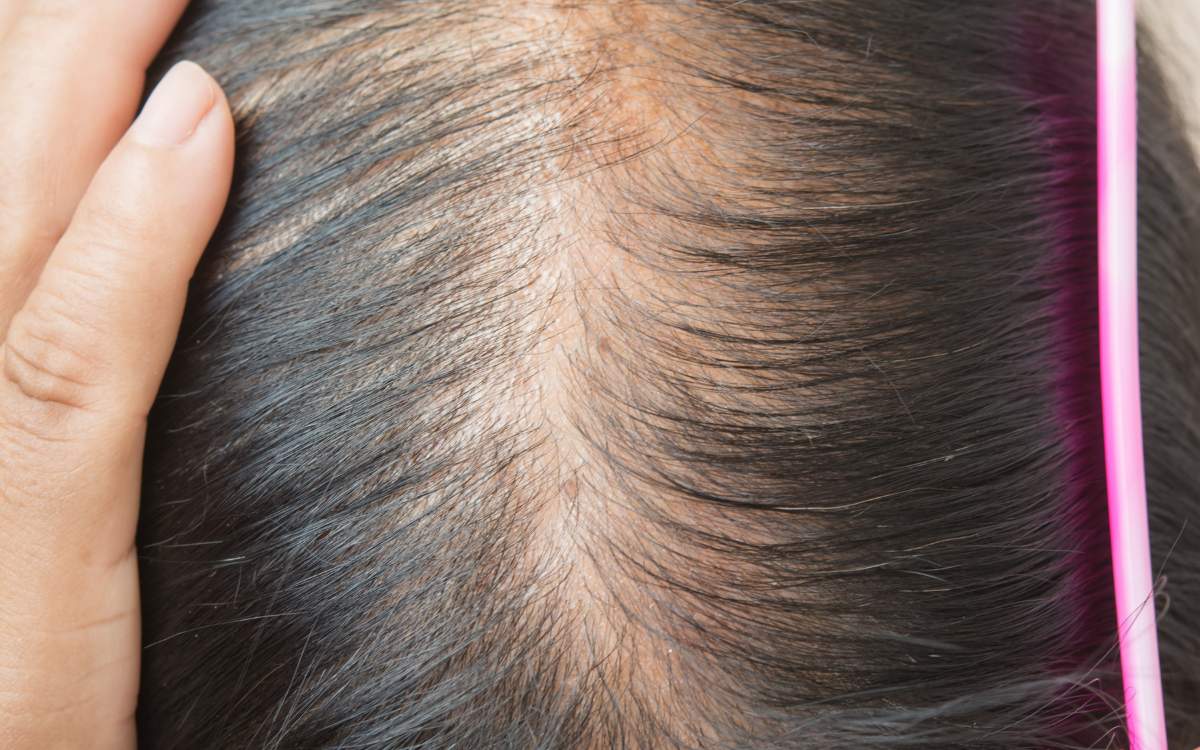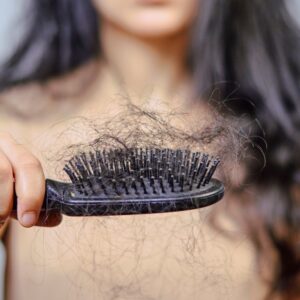how to stop thinning hair in women
$28.00
To stop thinning hair in women, consider using products with ingredients like biotin, keratin, and saw palmetto, which nourish hair follicles and promote growth. Additionally, maintaining a balanced diet rich in vitamins and minerals, reducing stress, and avoiding harsh hair treatments can significantly improve hair density and health. Regular scalp massages can also enhance circulation and stimulate hair growth.
Description
Comprehensive Guide to Stopping Thinning Hair in Women
Witnessing your hair lose its volume and density can be a distressing experience for women. Hair is often intertwined with identity, confidence, and self-perception. While some shedding is normal, noticeable thinning can trigger anxiety and a search for solutions. The good news is that in many cases, hair thinning in women can be addressed and even reversed with the right understanding and proactive steps.
This comprehensive guide delves into the common causes of hair thinning in women and provides detailed strategies to help you combat it and promote healthier, fuller hair.
Understanding the Roots of the Problem: Common Causes of Hair Thinning in Women
Before diving into solutions, it’s crucial to understand the potential culprits behind your thinning hair. Identifying the underlying cause is the first step towards effective treatment.
- Hormonal Fluctuations: This is a significant factor for many women.
- Menopause: The decline in estrogen levels during menopause can lead to hair thinning, often referred to as androgenetic alopecia or female pattern baldness.
- Postpartum Hair Loss (Telogen Effluvium): Hormonal shifts after childbirth can cause a temporary but noticeable increase in hair shedding.
- Birth Control Pills: Starting or stopping certain hormonal contraceptives can sometimes trigger hair thinning.
- Thyroid Imbalances: Both hypothyroidism (underactive thyroid) and hyperthyroidism (overactive thyroid) can disrupt hair growth cycles.
- Polycystic Ovary Syndrome (PCOS): Hormonal imbalances associated with PCOS can lead to increased androgens, which can contribute to hair thinning.
- Genetics (Androgenetic Alopecia): Just like men, women can inherit a predisposition to pattern baldness. This typically manifests as a widening part and overall thinning, rather than a receding hairline.
- Nutritional Deficiencies: Hair growth requires essential nutrients. Deficiencies in:
- Iron: Low iron levels (anemia) are a common cause of hair loss in women.
- Zinc: Zinc plays a crucial role in hair tissue growth and repair.
- Biotin (Vitamin B7): While severe deficiency is rare, inadequate biotin can impact hair health.
- Vitamin D: Emerging research suggests a link between low vitamin D levels and hair loss.
- Protein: Hair is primarily made of protein (keratin), so insufficient intake can affect growth.
- Stress (Telogen Effluvium): Significant physical or emotional stress can shock the hair follicles, leading to increased shedding a few months later. This is often temporary but can be alarming.
- Hairstyling Practices and Product Use:
- Tight Hairstyles: Ponytails, braids, and weaves pulled too tightly can cause traction alopecia, leading to hair loss, especially around the hairline.
- Heat Styling: Excessive use of heat tools (straighteners, curling irons) can weaken the hair shaft, leading to breakage and the appearance of thinning.
- Harsh Chemical Treatments: Perms, relaxers, and harsh dyes can damage the hair and scalp, contributing to hair loss.
- Medical Conditions and Medications: Certain medical conditions (e.g., autoimmune diseases like lupus) and medications (e.g., chemotherapy, blood thinners) can cause hair thinning as a side effect.
- Scalp Conditions: Conditions like seborrheic dermatitis (dandruff), psoriasis, and fungal infections can inflame the scalp and interfere with hair growth.
- Aging: As we age, hair follicles naturally shrink, and hair growth slows down, leading to a gradual decrease in hair density.
Taking Action: Strategies to Stop and Reverse Hair Thinning
Once you have a better understanding of the potential causes, you can implement targeted strategies to address the issue.
1. Consult a Healthcare Professional:
- See a Doctor or Dermatologist: This is the most crucial first step. A doctor can help identify the underlying cause of your hair thinning through a physical examination, blood tests (to check hormone levels, iron, thyroid function, etc.), and a review of your medical history and medications. A dermatologist specializing in hair disorders can provide a more in-depth evaluation and recommend appropriate treatments.
2. Nourish Your Hair from Within:
- Prioritize a Balanced Diet: Ensure your diet is rich in the essential nutrients mentioned earlier (iron, zinc, biotin, vitamin D, protein). Include lean meats, fish, eggs, dairy, leafy greens, nuts, seeds, and whole grains.
- Consider Supplements (with Doctor’s Approval): If blood tests reveal deficiencies, your doctor may recommend specific supplements. Avoid self-medicating, as excessive intake of some nutrients can also be harmful.
- Stay Hydrated: Drink plenty of water to support overall health and hair follicle function.
3. Nurture Your Scalp:
- Gentle Hair Care Routine:
- Use a Mild Shampoo and Conditioner: Avoid harsh chemicals and sulfates that can strip your hair and scalp of natural oils.
- Be Gentle When Washing: Avoid vigorous scrubbing. Gently massage your scalp to stimulate blood flow.
- Detangle Carefully: Use a wide-tooth comb and start detangling from the ends, working your way up.
- Limit Washing Frequency: Overwashing can dry out your scalp. Find a washing schedule that suits your hair type.
- Scalp Massage: Regular scalp massage can increase blood circulation to the hair follicles, promoting hair growth. You can do this while washing your hair or with oils.
- Consider Scalp Treatments: Depending on the cause of thinning, your dermatologist may recommend medicated shampoos or topical solutions for scalp conditions.
4. Adjust Your Hairstyling Habits:
- Loosen Up Tight Hairstyles: Avoid consistently wearing tight ponytails, braids, or weaves that pull on the hair follicles. Opt for looser styles.
- Minimize Heat Styling: Reduce the frequency of using heat tools. When you do, use a heat protectant spray.
- Be Cautious with Chemical Treatments: Space out perms, relaxers, and coloring treatments. Consider gentler, ammonia-free dyes.
- Consider Hair Extensions Wisely: While extensions can provide temporary volume, improper application or removal can damage your natural hair and worsen thinning. Consult a professional.
5. Manage Stress Levels:
- Practice Relaxation Techniques: Incorporate stress-reducing activities into your routine, such as yoga, meditation, deep breathing exercises, or spending time in nature.
- Ensure Adequate Sleep: Aim for 7-9 hours of quality sleep per night, as sleep is crucial for overall health and hormone regulation.
- Seek Support: Talk to friends, family, or a therapist if you’re experiencing significant stress or anxiety.
6. Explore Medical Treatments (Under Dermatological Guidance):
- Minoxidil (Rogaine for Women): This over-the-counter topical medication can help stimulate hair growth and slow down hair loss in some women with androgenetic alopecia.
- Prescription Medications: Your dermatologist may prescribe medications like spironolactone (an anti-androgen) or finasteride (though less commonly used in premenopausal women) to address hormonal imbalances contributing to hair loss.
- Low-Level Laser Therapy (LLLT): This non-invasive treatment uses red light to stimulate hair follicles and promote growth. At-home devices and in-office treatments are available.
- Platelet-Rich Plasma (PRP) Therapy: This involves injecting concentrated platelets from your own blood into the scalp to stimulate hair growth.
- Hair Transplantation: In cases of significant and persistent hair loss, hair transplantation surgery can be an option to restore hair density.
7. Be Patient and Consistent:
Hair growth is a slow process. It can take several months to see noticeable improvements after implementing changes or starting treatment. Be patient and consistent with your chosen strategies. Track your progress with photos to help you stay motivated.
Embracing Self-Care and Seeking Support:
Dealing with hair thinning can be emotionally challenging. Remember to practice self-compassion and focus on what you can control. Seek support from friends, family, or online communities if you need it. There are many resources available to help you navigate this experience.
The Takeaway:
Thinning hair in women is a multifaceted issue with various potential causes. By understanding these causes, adopting a holistic approach that includes proper nutrition, gentle hair care, stress management, and seeking professional guidance, you can take proactive steps to stop and potentially reverse hair thinning, ultimately leading to healthier, fuller, and more confident locks. Remember that you are not alone, and there are effective solutions available. Start your journey towards healthier hair today!





Reviews
There are no reviews yet.